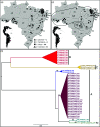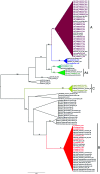The emergence of wildlife species as a source of human rabies infection in Brazil
- PMID: 23433340
- PMCID: PMC9151618
- DOI: 10.1017/S0950268813000198
The emergence of wildlife species as a source of human rabies infection in Brazil
Abstract
Forty-five human rabies virus isolates from a wide geographical area of Brazil were characterized using an anti-nucleoprotein monoclonal antibody panel and by partial nucleotide sequencing analysis of the nucleoprotein gene. Three major antigenic groups related to the antigenic variants maintained in domestic dogs, vampire bats and marmosets were identified. Phylogenetic analyses revealed that the viruses from dog-related cases segregated into four sister clades: three associated with dog-endemic cycles in Brazil and one with the crab-eating fox cycle in the northeastern region of the country. The vampire bat- and marmoset-related viruses formed two independent groups. The topology of these clades was conserved when these samples were compared to virus representatives of the currently reported rabies endemic cycles in the Americas. These results indicated the presence of multiple endemic transmission cycles maintained in four different reservoirs, domestic dogs, crab-eating foxes, vampire bats and marmosets, which are being transmitted directly to humans and should be considered as a high-risk for rabies infection.
Figures



Similar articles
-
Antigenic and genetic characterization of rabies viruses isolated from domestic and wild animals of Brazil identifies the hoary fox as a rabies reservoir.J Gen Virol. 2005 Nov;86(Pt 11):3153-3162. doi: 10.1099/vir.0.81223-0. J Gen Virol. 2005. PMID: 16227239
-
Rabies virus maintained by dogs in humans and terrestrial wildlife, Ceará State, Brazil.Emerg Infect Dis. 2006 Dec;12(12):1978-81. doi: 10.3201/eid1212.060429. Emerg Infect Dis. 2006. PMID: 17326958 Free PMC article.
-
Discrimination between dog-related and vampire bat-related rabies viruses in Brazil by strain-specific reverse transcriptase-polymerase chain reaction and restriction fragment length polymorphism analysis.J Clin Virol. 2003 Apr;26(3):317-30. doi: 10.1016/s1386-6532(02)00048-3. J Clin Virol. 2003. PMID: 12637081
-
Vampire bat rabies: ecology, epidemiology and control.Viruses. 2014 Apr 29;6(5):1911-28. doi: 10.3390/v6051911. Viruses. 2014. PMID: 24784570 Free PMC article. Review.
-
Oral vaccination of wildlife against rabies: opportunities and challenges in prevention and control.Dev Biol (Basel). 2004;119:173-84. Dev Biol (Basel). 2004. PMID: 15742629 Review.
Cited by
-
Using Surveillance of Animal Bite Patients to Decipher Potential Risks of Rabies Exposure From Domestic Animals and Wildlife in Brazil.Front Public Health. 2020 Jul 22;8:318. doi: 10.3389/fpubh.2020.00318. eCollection 2020. Front Public Health. 2020. PMID: 32850575 Free PMC article.
-
Clinical aspects of human rabies in the state of Ceará, Brazil: an overview of 63 cases.Rev Soc Bras Med Trop. 2021 Jul 23;54:e01042021. doi: 10.1590/0037-8682-0104-2021. eCollection 2021. Rev Soc Bras Med Trop. 2021. PMID: 34320131 Free PMC article.
-
The Importance of Accurate Host Species Identification in the Framework of Rabies Surveillance, Control and Elimination.Viruses. 2022 Feb 28;14(3):492. doi: 10.3390/v14030492. Viruses. 2022. PMID: 35336899 Free PMC article.
-
Fifty Years of the National Rabies Control Program in Brazil under the One Health Perspective.Pathogens. 2023 Nov 11;12(11):1342. doi: 10.3390/pathogens12111342. Pathogens. 2023. PMID: 38003806 Free PMC article.
-
A Novel Terrestrial Rabies Virus Lineage Occurring in South America: Origin, Diversification, and Evidence of Contact between Wild and Domestic Cycles.Viruses. 2021 Dec 11;13(12):2484. doi: 10.3390/v13122484. Viruses. 2021. PMID: 34960753 Free PMC article.
References
-
- Brazil Ministry of Health. COVEV/CGDT/DEVEP/SVS/MS. (http://portal.saude.gov.br/portal/saude/profissional/area.cfm?id_area=1567) [available only in Portuguese]. Accessed 27 August 2012.
-
- World Health Organization. Technical Report Series 931. WHO Expert Consultation on rabies. First report, Geneva, 2004. - PubMed
MeSH terms
Substances
Associated data
- Actions
- Actions
- Actions
- Actions
- Actions
- Actions
- Actions
- Actions
- Actions
- Actions
- Actions
- Actions
- Actions
- Actions
- Actions
- Actions
- Actions
- Actions
- Actions
- Actions
- Actions
- Actions
- Actions
- Actions
- Actions
- Actions
- Actions
- Actions
- Actions
- Actions
- Actions
- Actions
- Actions
- Actions
- Actions
- Actions
- Actions
- Actions
- Actions
- Actions
- Actions
- Actions
- Actions
- Actions
- Actions
LinkOut - more resources
Full Text Sources
Other Literature Sources
Medical

